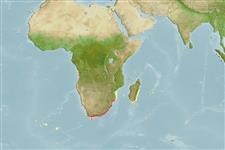>
Eupercaria/misc (Various families in series Eupercaria) >
Sparidae (Porgies)
Etymology: Rhabdosargus: Greek, rhabdos = stick + Latin, sargus = sargus (1591) (Ref. 45335).
More on author: Steindachner.
Environment: milieu / climate zone / depth range / distribution range
นิเวศวิทยา
เกี่ยวกับทะเล,น้ำเค็ม; กร่อย สัตว์น้ำหน้าดิน; สัตว์น้ำที่อาศัยและอพยพภายในทะเลเท่านั้น (Ref. 51243). Subtropical
Southeast Atlantic: South Africa, from the Cape to Natal.
Length at first maturity / ขนาด / น้ำหนัก / Age
Maturity: Lm 19.0 range ? - ? cm
Max length : 40.0 cm TL เพศผู้/กระเทย; (Ref. 3507); common length : 15.0 cm TL เพศผู้/กระเทย; (Ref. 3198)
Short description
เครื่องมือที่ใช้ในการแยกชนิดสัตว์,สิ่งมีชีวิตออกจากกัน | สัณฐานวิทยา | ความยาวต่างๆ
เงี่ยงครีบหลัง (รวม) : 11; ก้านครีบอ่อนที่หาง (รวม) : 12 - 13; เงี่ยงครีบก้น: 3; ก้านครีบอ่อนที่ก้น: 10 - 11. Silvery with golden midlateral band from head to caudal peduncle (Ref. 3198).
Inhabits estuaries and shallow waters over sand and between rocks. Feeds mainly on small bivalves, shrimps and crabs (Ref. 3670). Flesh excellent (Ref. 3198).
Life cycle and mating behavior
Maturities | การสืบพันธุ์ | Spawnings | Egg(s) | Fecundities | ตัวอ่อน
Smith, J.L.B. and M.M. Smith, 1986. Sparidae. p. 580-594. In M.M. Smith and P.C. Heemstra (eds.) Smiths' sea fishes. Springer-Verlag, Berlin. (Ref. 3198)
IUCN Red List Status (Ref. 130435)
Threat to humans
Harmless
Human uses
การประมง: มีการค้าเพียงเล็กน้อย; การตกปลาเป็นกีฬา: ใช่; เหยื่อ: usually
เครื่องมือ
Special reports
Download XML
แหล่งที่มาจากอินเตอร์เน็ต
Estimates based on models
Preferred temperature (Ref.
123201): 17.5 - 27.6, mean 25.6 °C (based on 237 cells).
Phylogenetic diversity index (Ref.
82804): PD
50 = 0.5156 [Uniqueness, from 0.5 = low to 2.0 = high].
Bayesian length-weight: a=0.01738 (0.01067 - 0.02829), b=3.06 (2.92 - 3.20), in cm total length, based on LWR estimates for this species & (Sub)family-body (Ref.
93245).
ระดับชั้นอาหาร (Ref.
69278): 2.8 ±0.2 se; based on diet studies.
ความสามารถในการกลับคืนสู่ปกติ (Ref.
120179): ขนาดกลาง, เวลาต่ำสุดที่จะทำให้ประชากรเพิ่มขึ้นเป็น 2 เท่าใช้เวลา 1.4 - 4.4 ปี (Preliminary K or Fecundity.).
Fishing Vulnerability (Ref.
59153): Low to moderate vulnerability (30 of 100).
Nutrients (Ref.
124155): Calcium = 91.6 [48.0, 177.6] mg/100g; Iron = 1.13 [0.65, 2.08] mg/100g; Protein = 19.5 [18.6, 20.5] %; Omega3 = 0.379 [0.257, 0.596] g/100g; Selenium = 23.5 [11.8, 42.1] μg/100g; VitaminA = 11.6 [3.9, 29.5] μg/100g; Zinc = 1.07 [0.75, 1.50] mg/100g (wet weight);
